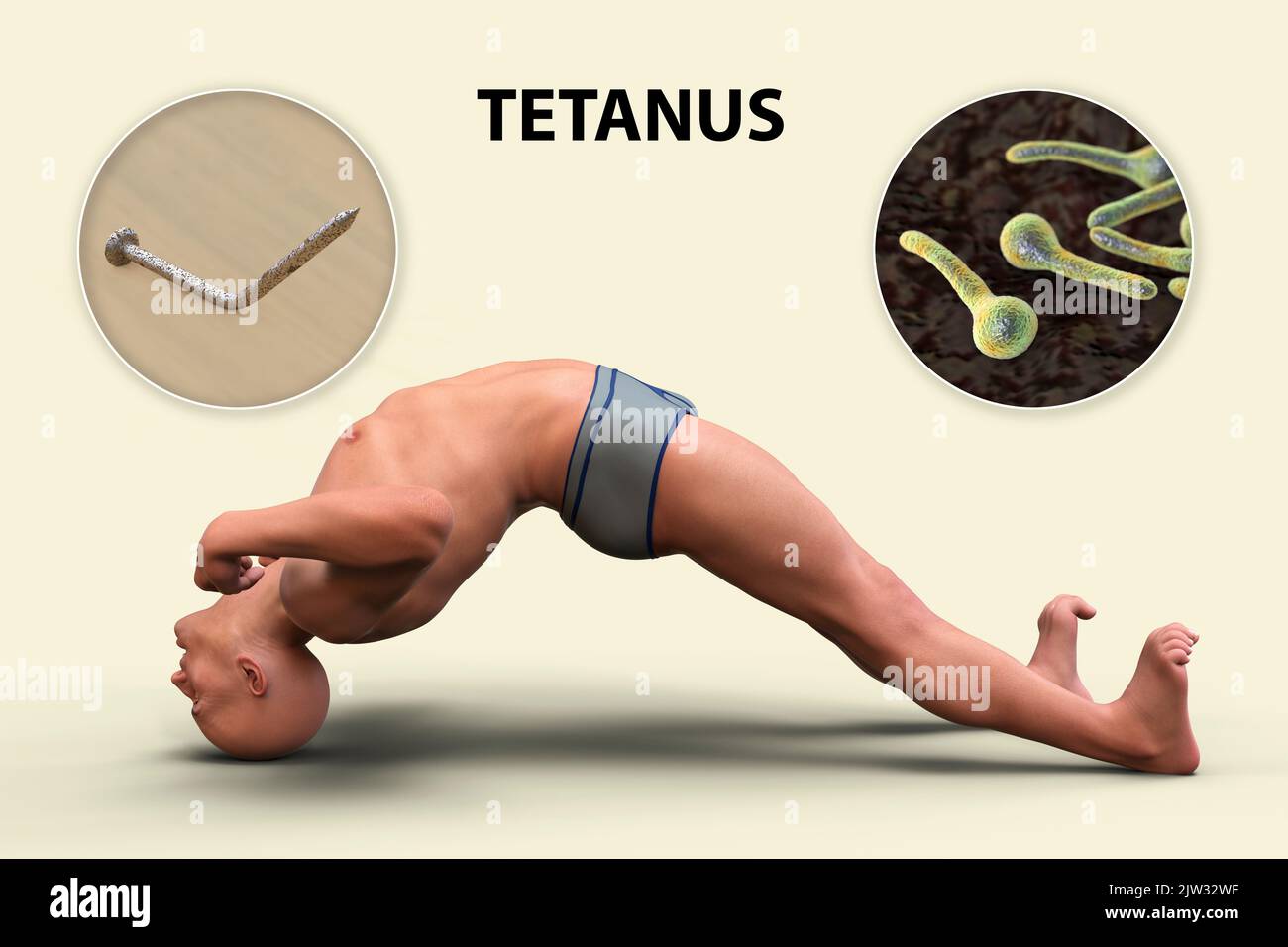···
Mechanism of tetanus disease, illustration. A skin wound is contaminated with Clostridium tetani bacteria that produce a neurotoxin that reaches the spinal cord and causes spastic paralysis. The man is in opisthotonus (backward spasm), a state of severe hyperextension and spasticity. Image details File size:
68.7 MB (1 MB Compressed download)
Open your image file to the full size using image processing software.
Dimensions:
6000 x 4000 px | 50.8 x 33.9 cm | 20 x 13.3 inches | 300dpi
Date taken:
31 August 2022
Search stock photos by tags
Similar stock images Mechanism of tetanus disease, illustration. A skin wound is contaminated with Clostridium tetani bacteria that produce a neurotoxin that reaches the spinal cord and causes spastic paralysis. The man is in opisthotonus (backward spasm), a state of severe hyperextension and spasticity. Stock Photo https://www.alamy.com/image-license-details/?v=1 https://www.alamy.com/mechanism-of-tetanus-disease-illustration-a-skin-wound-is-contaminated-with-clostridium-tetani-bacteria-that-produce-a-neurotoxin-that-reaches-the-spinal-cord-and-causes-spastic-paralysis-the-man-is-in-opisthotonus-backward-spasm-a-state-of-severe-hyperextension-and-spasticity-image480114458.html RF 2JW32TX – Mechanism of tetanus disease, illustration. A skin wound is contaminated with Clostridium tetani bacteria that produce a neurotoxin that reaches the spinal cord and causes spastic paralysis. The man is in opisthotonus (backward spasm), a state of severe hyperextension and spasticity. Mechanism of tetanus disease, illustration. A skin wound is contaminated with Clostridium tetani bacteria that produce a neurotoxin that reaches the spinal cord and causes spastic paralysis. The man is in opisthotonus (backward spasm), a state of severe hyperextension and spasticity. Stock Photo https://www.alamy.com/image-license-details/?v=1 https://www.alamy.com/mechanism-of-tetanus-disease-illustration-a-skin-wound-is-contaminated-with-clostridium-tetani-bacteria-that-produce-a-neurotoxin-that-reaches-the-spinal-cord-and-causes-spastic-paralysis-the-man-is-in-opisthotonus-backward-spasm-a-state-of-severe-hyperextension-and-spasticity-image480114441.html RF 2JW32T9 – Mechanism of tetanus disease, illustration. A skin wound is contaminated with Clostridium tetani bacteria that produce a neurotoxin that reaches the spinal cord and causes spastic paralysis. The man is in opisthotonus (backward spasm), a state of severe hyperextension and spasticity. Mechanism of tetanus disease, illustration. A skin wound is contaminated with Clostridium tetani bacteria that produce a neurotoxin that reaches the spinal cord and causes spastic paralysis. The man is in opisthotonus (backward spasm), a state of severe hyperextension and spasticity. Stock Photo https://www.alamy.com/image-license-details/?v=1 https://www.alamy.com/mechanism-of-tetanus-disease-illustration-a-skin-wound-is-contaminated-with-clostridium-tetani-bacteria-that-produce-a-neurotoxin-that-reaches-the-spinal-cord-and-causes-spastic-paralysis-the-man-is-in-opisthotonus-backward-spasm-a-state-of-severe-hyperextension-and-spasticity-image480114450.html RF 2JW32TJ – Mechanism of tetanus disease, illustration. A skin wound is contaminated with Clostridium tetani bacteria that produce a neurotoxin that reaches the spinal cord and causes spastic paralysis. The man is in opisthotonus (backward spasm), a state of severe hyperextension and spasticity. Mechanism of tetanus disease, illustration. A skin wound is contaminated with Clostridium tetani bacteria that produce a neurotoxin that reaches the spinal cord and causes spastic paralysis. The man is in opisthotonus (backward spasm), a state of severe hyperextension and spasticity. Stock Photo https://www.alamy.com/image-license-details/?v=1 https://www.alamy.com/mechanism-of-tetanus-disease-illustration-a-skin-wound-is-contaminated-with-clostridium-tetani-bacteria-that-produce-a-neurotoxin-that-reaches-the-spinal-cord-and-causes-spastic-paralysis-the-man-is-in-opisthotonus-backward-spasm-a-state-of-severe-hyperextension-and-spasticity-image480114440.html RF 2JW32T8 – Mechanism of tetanus disease, illustration. A skin wound is contaminated with Clostridium tetani bacteria that produce a neurotoxin that reaches the spinal cord and causes spastic paralysis. The man is in opisthotonus (backward spasm), a state of severe hyperextension and spasticity. 